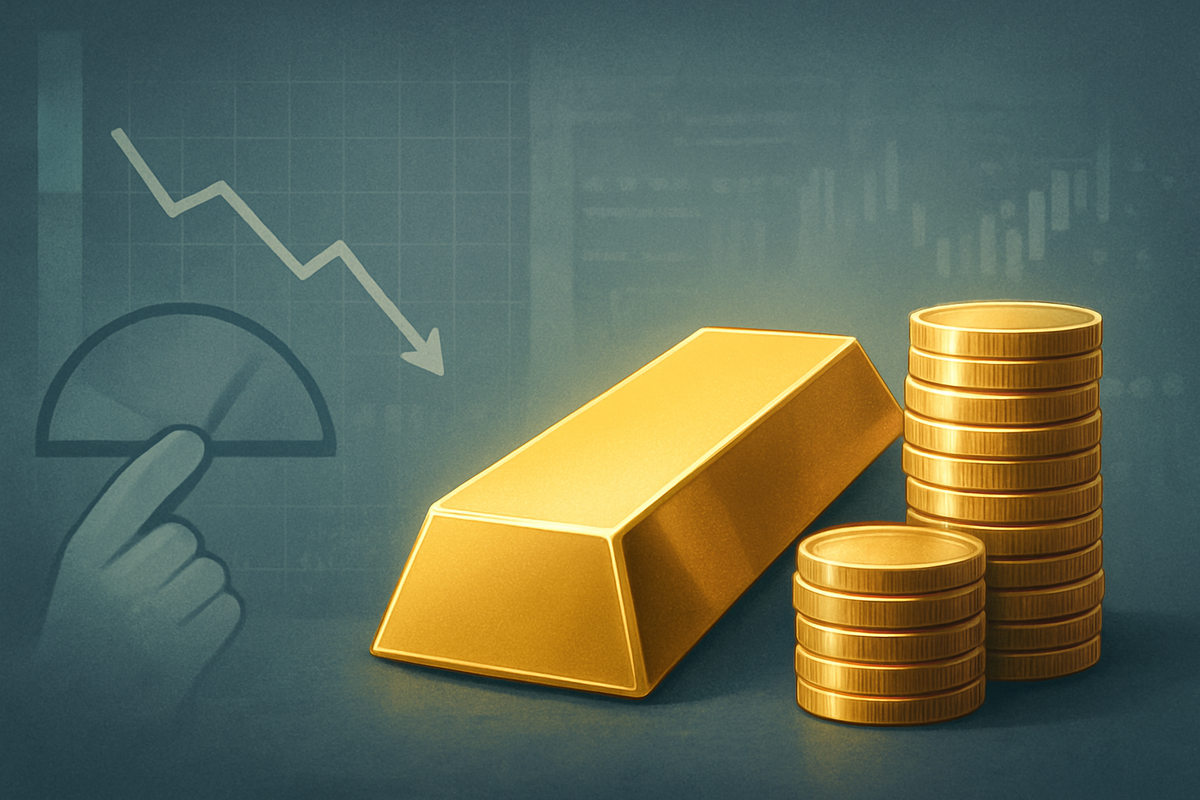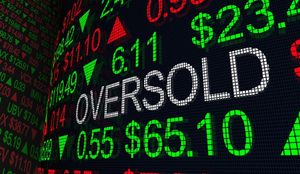
The financial markets are abuzz with heightened speculation surrounding a potential Federal Reserve interest rate cut in December 2025. This surge in dovish sentiment is primarily fueled by recent signals from influential Fed officials and a slew of economic data pointing to stalling inflation and a notable weakening in consumer spending and the labor market. The immediate implication has been a significant rally in gold prices, as investors flock to the safe-haven asset, anticipating a more accommodative monetary policy environment.
This shift in outlook is creating a complex landscape for investors, as the prospect of lower borrowing costs clashes with underlying concerns about economic deceleration. While gold is enjoying a resurgence, the US dollar faces downward pressure, and equity markets navigate a mixed sentiment, balancing the benefits of cheaper credit against worries of a softening economy. The upcoming Federal Open Market Committee (FOMC) meeting in early December and subsequent economic reports are poised to be critical determinants of market direction in the final weeks of 2025.
Fed's Dovish Pivot Fuels Market Expectations
The catalyst for this intensified speculation arrived with recent commentary from Federal Reserve Governor Christopher Waller and New York Fed President John Williams. Governor Waller publicly advocated for a December rate cut, emphasizing persistent weakness in the labor market as his primary concern, while downplaying inflation worries. Similarly, President Williams suggested the Fed could lower rates without jeopardizing inflation targets, citing increased downside risks to employment and easing inflation pressures. These dovish remarks have significantly swayed market sentiment, with the CME FedWatch Tool now indicating probabilities exceeding 70% for a 25-basis-point reduction at the December 9-10 FOMC meeting, a sharp increase from just 40% a week prior.
This pivot in Fed rhetoric comes against a backdrop of lukewarm economic data. The Consumer Price Index (CPI) for September 2025 showed a 3.0% year-over-year increase, with core CPI also at 3.0%. The Producer Price Index (PPI) similarly indicated stalling rather than accelerating inflation. More concerning, however, has been the evident slowdown in consumer activity. US retail sales for September registered a weaker-than-expected increase of only 0.2% month-over-month, and consumer confidence in November plummeted to its lowest level since April, driven by anxieties over jobs and financial well-being. The labor market, too, is showing cracks, with September nonfarm payrolls rising by a modest 119,000 and the unemployment rate ticking up to 4.4%.
In response to these developments, gold prices have surged. Spot gold climbed nearly 2% on Monday, November 24th, following the dovish Fed comments, breaking past the $4,100 mark and reaching over $4,147 per ounce. This immediate reaction underscores gold's traditional role as a beneficiary of lower interest rates, as the opportunity cost of holding the non-yielding asset decreases. Key stakeholders involved include the Federal Reserve, global investors, and major gold mining companies, all closely monitoring every nuance of economic data and central bank communication. The recent six-week government shutdown has further complicated the economic picture, delaying key reports and adding an extra layer of uncertainty to the Fed's decision-making process.
Corporate Fortunes: Winners and Losers in a Lower Rate Environment
The implications of potential Federal Reserve rate cuts and rallying gold prices are sharply divided across various sectors of the public market, creating clear winners and those facing headwinds. Unsurprisingly, gold mining companies are poised to be the primary beneficiaries. As the price of gold surges, their revenue and profit margins expand significantly due to operational leverage, where many costs remain relatively fixed. Companies like Newmont Corporation (NYSE: NEM), Barrick Gold Corporation (NYSE: GOLD), and Agnico Eagle Mines Limited (NYSE: AEM) are already seeing increased investor interest, with their stock performance often closely tracking the commodity's upward trajectory. Gold streaming and royalty companies, such as Franco-Nevada Corporation (NYSE: FNV), also stand to gain substantially from higher gold prices without the direct operational risks of mining.
Beyond precious metals, a broader range of sectors stands to benefit from a lower interest rate environment. Technology companies, particularly those with high growth potential or significant capital expenditures, will find borrowing cheaper, facilitating investments in R&D, expansion, and M&A. This could provide a tailwind for giants like Apple Inc. (NASDAQ: AAPL) and NVIDIA Corporation (NASDAQ: NVDA) by reducing their cost of capital and boosting valuations. The real estate and homebuilding sectors are also poised for a boost, as lower interest rates translate to more affordable mortgages, stimulating homebuyer demand and potentially increasing property values. Homebuilders such as D.R. Horton, Inc. (NYSE: DHI) could see increased sales volumes.
Conversely, financial institutions, particularly large traditional banks, face a more complex and often challenging outlook. While lower rates can stimulate loan demand, they typically compress net interest margins (NIMs)—the difference between interest earned on loans and interest paid on deposits. Banks like JPMorgan Chase & Co. (NYSE: JPM) and Bank of America Corporation (NYSE: BAC) might see their profitability squeezed as the rates they earn on assets fall faster than they can reduce rates on liabilities. However, some FinTech companies focused on lending, such as SoFi Technologies (NASDAQ: SOFI), might find reduced funding costs beneficial, positioning them as potential winners within the broader financial sector. The overall impact on banks will depend on their loan portfolios, deposit structures, and ability to adapt to a lower-rate environment.
Broader Significance and Historical Parallels
The Federal Reserve's anticipated pivot towards interest rate cuts carries wider significance, reverberating through global financial markets and shaping broader industry trends. This shift is not merely about adjusting borrowing costs; it represents a recalibration of economic priorities, potentially signaling the Fed's increased concern for employment stability over persistent, albeit moderating, inflation. The ongoing debate within the Federal Open Market Committee (FOMC) highlights this internal struggle, further complicated by data gaps stemming from the recent government shutdown, forcing policymakers to rely on incomplete information.
Across industries, the ripple effects are substantial. Lower borrowing costs are expected to stimulate corporate investment, encouraging businesses to expand, innovate, and pursue mergers and acquisitions. This could particularly benefit capital-intensive sectors and growth-oriented technology companies, providing a tailwind for innovation and market expansion. Conversely, the prospect of cheaper credit could intensify competition, favoring companies with strong balance sheets and the agility to refinance existing debt. A weakening US dollar, a common consequence of rate cuts, could also attract capital inflows to emerging markets, making dollar-denominated debt more manageable for international entities and potentially boosting economies in regions like Mexico, India, and Indonesia.
Historically, periods of Federal Reserve easing have often coincided with significant rallies in gold prices. For instance, gold saw substantial increases in the 24 months following rate cuts in 2000, 2007, and 2019, underscoring its role as a hedge against economic uncertainty and a weakening dollar. This pattern is reinforced by the current trend of global central banks increasing their gold reserves, signaling a strategic diversification away from dollar dependency. However, the broader economic context is crucial; gold performs exceptionally well when rate cuts respond to slowdowns or crises, whereas "insurance" cuts against minor downturns might yield less pronounced effects. The conclusion of Quantitative Tightening (QT) by December 1, 2025, will also inject additional liquidity, further influencing market dynamics alongside potential rate cuts.
The Road Ahead: Scenarios and Strategic Considerations
The path forward for Federal Reserve policy, gold prices, and the broader economy is fraught with both opportunities and challenges, heavily contingent on incoming economic data and the Fed's delicate balancing act. In the short term, market participants overwhelmingly anticipate continued interest rate cuts, with probabilities for a December 2025 reduction nearing 80%. This easing cycle is expected to extend into early 2026, driven by the Fed's increasing concern over a softening labor market and moderating, albeit still elevated, inflation. However, the pace and extent of these cuts will likely be cautious and data-dependent, given the internal divisions within the FOMC and the complications arising from recent government shutdown-induced data gaps.
For gold, the short-term outlook remains decidedly bullish. Analysts from major financial institutions are forecasting further price appreciation, with some projections for spot gold to reach $4,500 per ounce by mid-2026 and even $5,000 by the end of 2026. This momentum is underpinned by the reduced opportunity cost of holding non-yielding assets in a lower-rate environment, coupled with gold's enduring appeal as a safe haven amidst global economic uncertainty, geopolitical tensions, and persistent inflation concerns. Investors should anticipate some volatility, but the overarching trend appears upward, encouraging a "buy on dips" strategy.
Looking further ahead, the US economy is projected to experience a period of moderating growth, slowing to around 1.8-2.0% in 2025 and 1.4-2.0% in 2026, a notable deceleration from previous years. While a full-blown recession is not the consensus, risks of a "soggy" growth environment with persistent inflation (stagflation) remain. The Fed's long-term challenge will be to guide inflation sustainably back to its 2% target without stifling economic activity. Strategic pivots in fiscal policy, trade relations (particularly tariffs), and the evolution of the labor market will be critical determinants. For investors, fixed-income markets may offer opportunities as bond yields react to rate cuts, while gold is expected to continue its role as a valuable portfolio hedge. The real estate market, however, may not see significant improvement until well into 2026, as it works through the effects of previously high mortgage rates.
Navigating the Evolving Market Landscape
The financial markets are at a pivotal juncture, largely shaped by the Federal Reserve's anticipated shift towards interest rate cuts, driven by a confluence of stalling inflation and weakening economic indicators. The immediate and most striking consequence has been a significant surge in gold prices, reaffirming its historical role as a safe-haven asset and a beneficiary of an accommodative monetary policy. This dynamic creates a complex environment where traditional market relationships are being tested, and investor vigilance is paramount.
Moving forward, the market will remain highly sensitive to every utterance from Fed officials and each incoming piece of economic data, particularly the November CPI report and the December FOMC meeting. The interplay between easing monetary policy, persistent inflationary pressures, and a softening labor market will define the economic narrative in the coming months. Companies directly tied to gold production stand to gain, while financial institutions may navigate a period of margin compression. Beyond these immediate impacts, the broader significance lies in the potential for renewed corporate investment, shifts in global capital flows, and the ongoing recalibration of central bank strategies worldwide.
Investors should closely monitor the Fed's communication for clarity on its rate-cutting trajectory, paying particular attention to any signs of division within the committee or unexpected strength in economic data that could alter the dovish outlook. Gold's performance will be a key indicator of market sentiment regarding inflation and economic stability. Additionally, watching for changes in consumer spending patterns, the trajectory of the US dollar, and the evolution of geopolitical events will be crucial for navigating the opportunities and challenges that emerge in this evolving financial landscape. The coming months promise to be a period of significant adjustment and potential volatility, demanding a well-informed and adaptable investment strategy.
This content is intended for informational purposes only and is not financial advice





